The Shakedown

If you want to know whether your bicycle's build is solid - and I mean, really, truly bulletproof - there is no better method than the so-called shakedown ride. Now, in bicycling parlance we throw the term around pretty liberally these days - typically when referring to riding a bicycle for the first time in a specific configuration to make sure everything works as it should. But the true shakedown ride is more than just that: It is a stress test, meant to bring any hidden weaknesses or problems to the surface quickly, so that they don't surprise you in the middle of long, important cycling trip later. A good proper shakedown ride should, quite literally, shake, jostle and vibrate the bejeezus out of your machine. And of course there is no more effective way to achieve this than over rough, unpaved surfaces. If something's going to start rattling, come loose, or go out of adjustment on your bike, it will happen faster on the rough stuff. It was for this reason, after all, that the French Technical Trials were held on unpaved terrain. Having made some final modifications to my own bicycle's setup, now I too was ready to submit it to the truth of the shakedown.

And so one fine afternoon my companion and I headed up the Glenveagh mountain trail - a beautiful, winding path that starts gentle, only to lure you into a steep, horrible climb to the very top of the mountain - the surface growing ever rougher and looser with each foot of elevation gain.

The more accoutrements one has on their machine, the more crucial the shakedown ride becomes. For along with the lovely functionality of fenders, racks, bags and lighting, comes the extra potential for failure under stress. There are more bolts to loosen. More stays to snap. More parts to rub and knock against each other if not fitted to utter perfection. More sources for mysterious noises to develop.
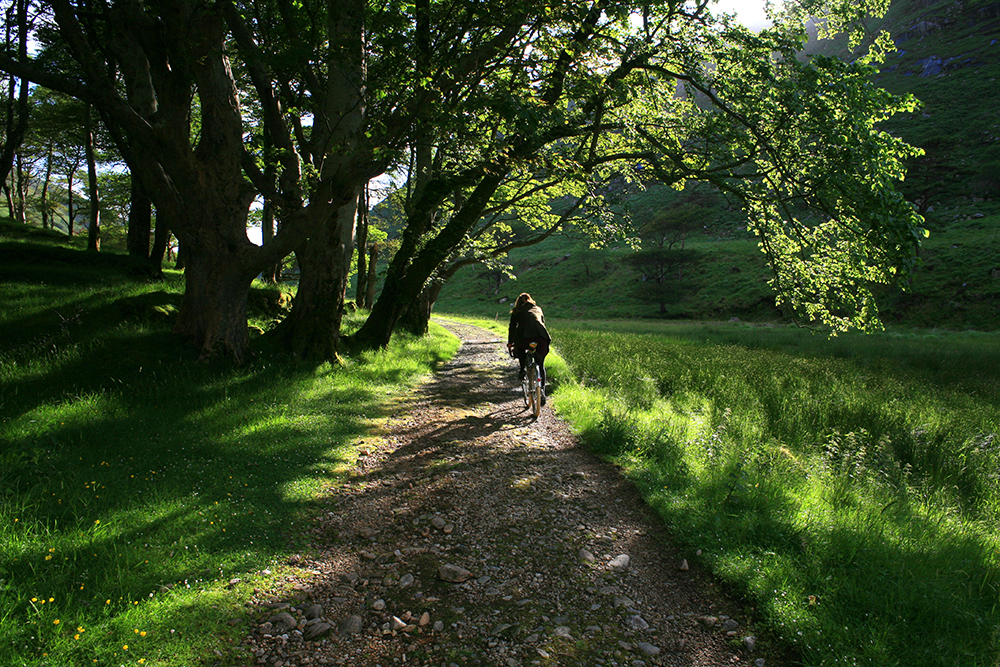
I had gotten my bicycle to the point of silence on the paved roads. But was this a stable state of affairs? The 20 mile jaunt up and down the mountain would answer that question.

With the Glenveagh setting so tranquil, the physicality of this ride nearly fades to the background at times. But in fact this is one of the steepest, more difficult climbs I have ever done. In the final stretch in particular, the combination of the steep pitch and the loose, sliding rocks made my wheel spin and slip aimlessly, forcing me to muster extra power I did not know I had to push my way through to the top.
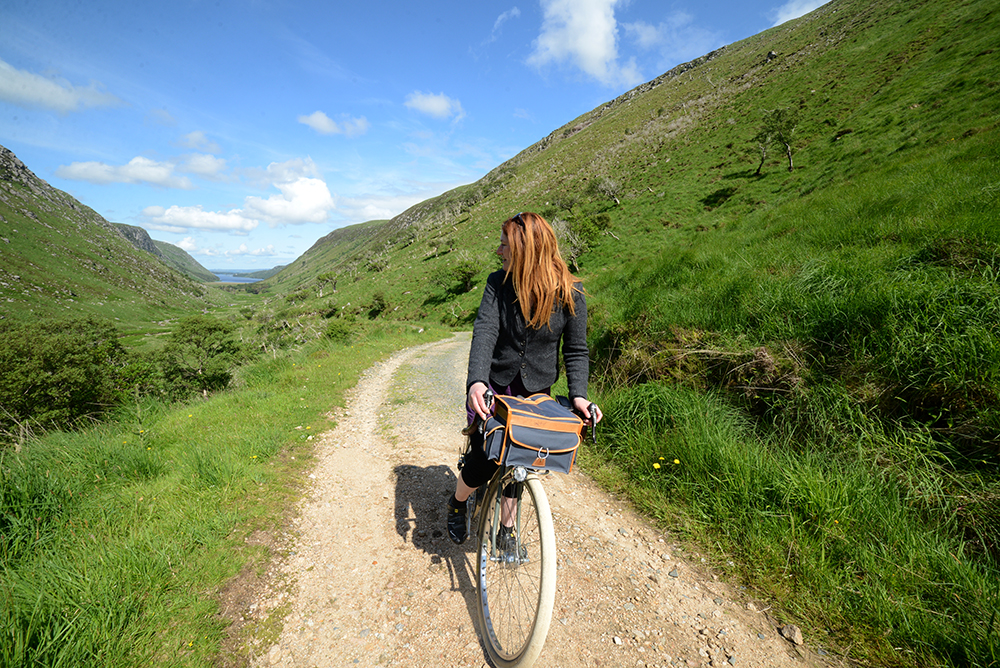
Looking back over the landscape we'd cycled through, I could hardly believe we had come from beyond that long lake which now resembled a tiny puddle in the far distance... or that I would have to descend toward it again. But of course it is the descent, with its combination of speed and bumpiness, that is the true essence of the shakedown ride.

So far only one thing had to be tweaked: The prongs of my plug-in decaleur (I use this VO system and love it) began to rattle inside the open tubes of the front rack they integrate with, which was something I'd never noticed before. I stopped to wrap tiny bits of electrical tape around the prongs to "pad" the connection and the rattling never returned.
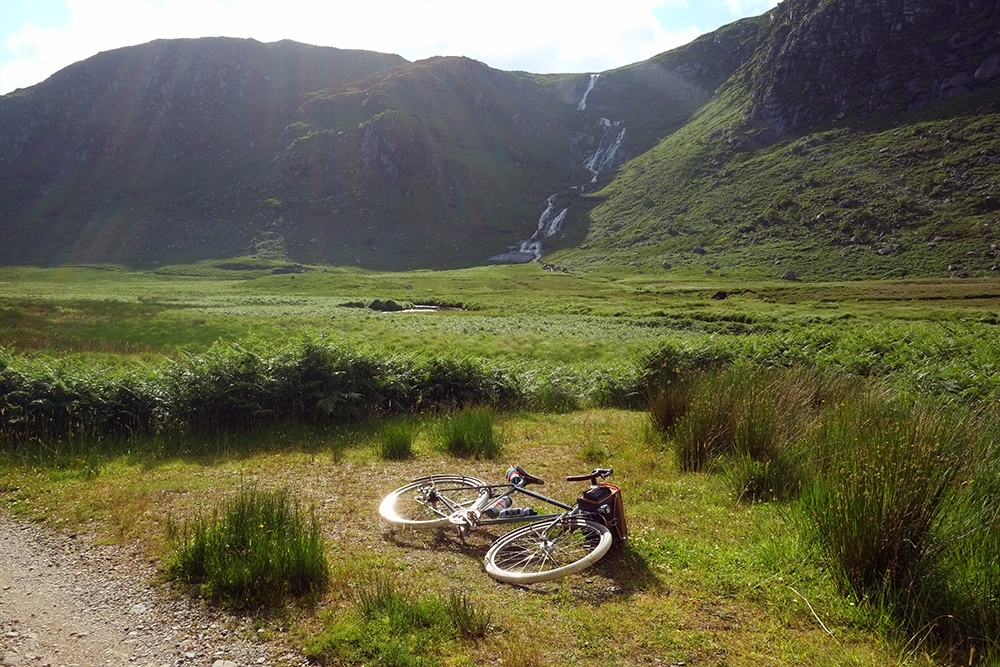
The too-fast descent was not as much physically, as psychologically exhausting, as it involved me mostly trusting my bicycle and my instincts to do their thing - while bombing down a winding path along the cliff edge through loose rock and over large jutting-out stones. Over the rougher part of the trail, the shaking and jolting were relentless. At some point my bike got tossed into the air and landed again. At another, I had picked up so much speed that the landscape blurred. Despite this, the descent had been silent, save for the sounds of the wind hissing in my ears and my own internal screaming.
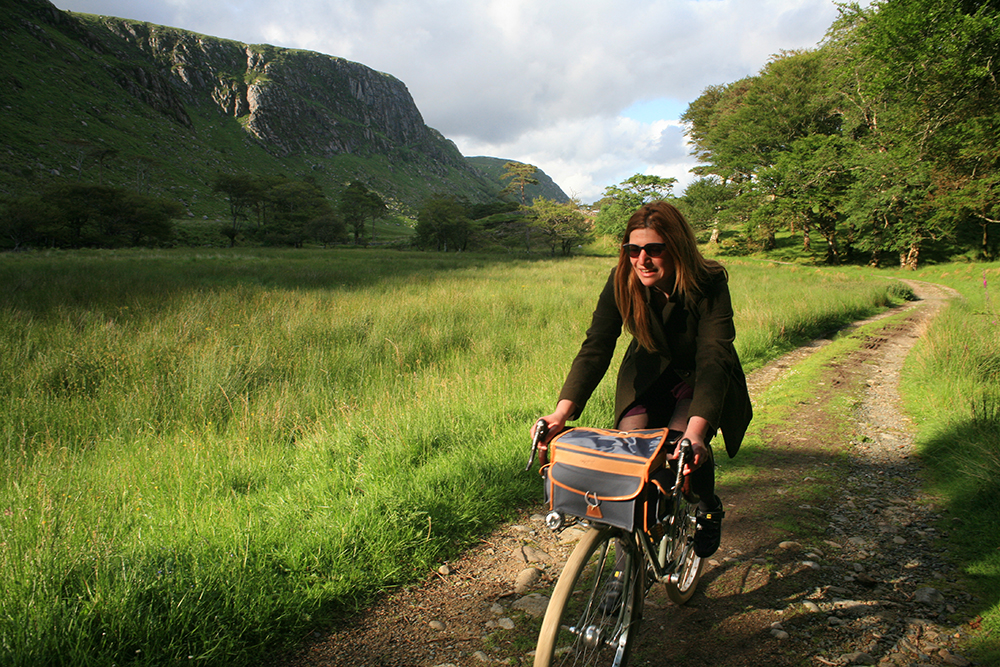
Properly shaken down, my bicycle was ready for long, adventurous rides to distant places.
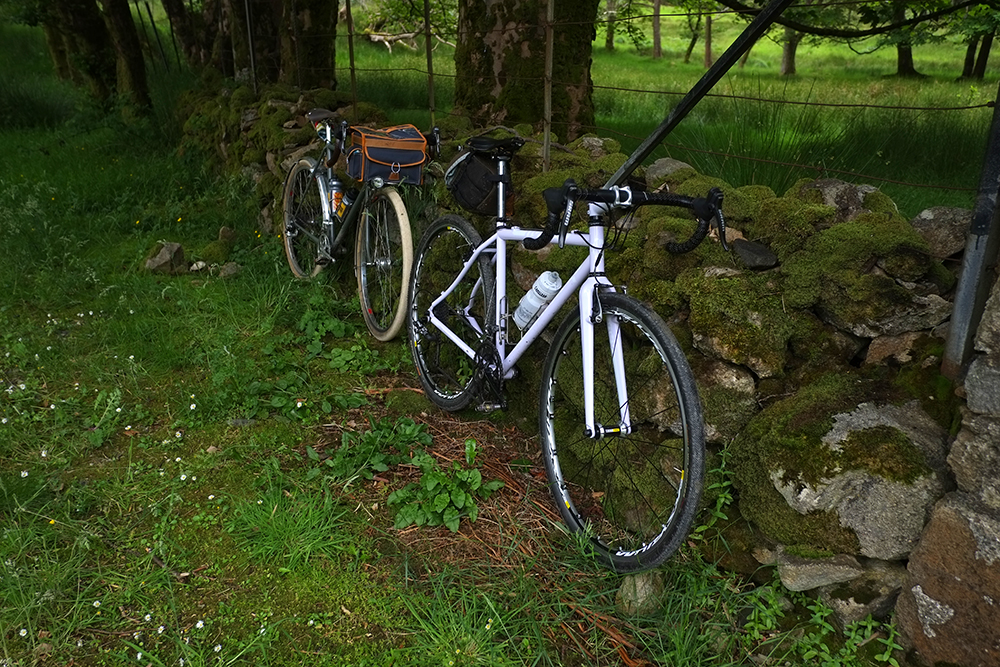
And while of course riding a pared-down bike makes things easier in some ways,
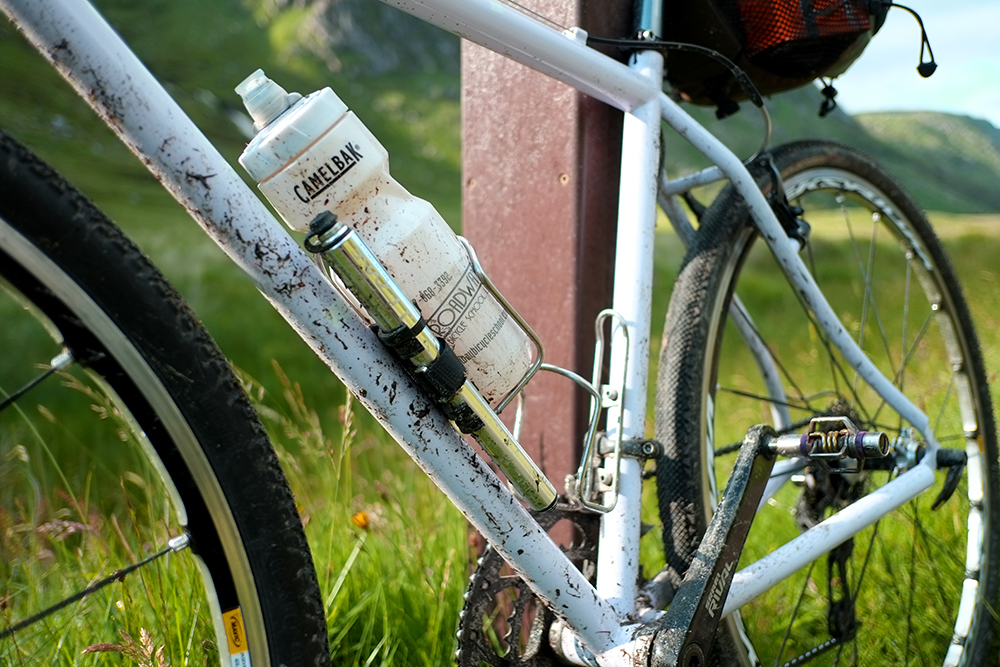
it makes things not so great in other ways, if you see what I mean. Pick your poison, but a good shakedown ride is in order regardless.
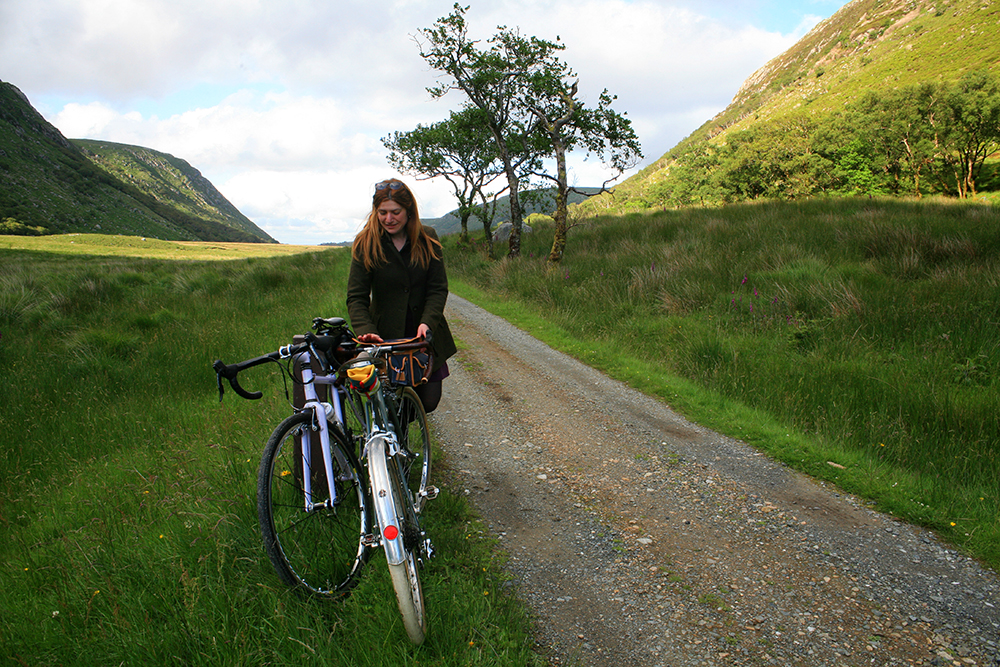
Having stopped to admire the scenery and now ready to get going again, I clipped in and pulled the pedal back to staring position, pleased as punch at my perfectly functional, non-rattly bicycle. And then my chain came off.
In the process of putting it back on, I discovered my drivetrain no longer wanted me to be in the big ring at all. I had worried so much about bolts and bag attachments, that I'd clear forgotten about my slightly finicky Campagnolo / Rene Herse drivetrain setup. Now it looked like it decided to transition from finicky to dysfunctional. Ah well. If I stayed in the small ring things seem to be stable, and so I would spin the rest of the way and wait to mess with the front derailleur at home.
"Something wrong with your gears?" my companion said, pulling up beside me. I expected to be teased for my complicated drivetrain, but it turned out his was acting up as well. So much for the benefits of a pared-down bike.

In the waning evening sun, we headed home to what promised to be a long evening of drivetrain maintenance. A post-shakedown ride shakedown ride was in the cards.

What were the final modifications you made to your bike before this shakedown? Changes in equipment? It's a good idea to become aware of every nut and bolt and the ins and outs of all one's equipment before long, adventurous rides. Seems a no brainer but so many assume they'll be no problems only to have wheel or drivetrain issues in the middle of nowhere. Knowing what spare parts/tools to bring along becomes part of the shakedown. Enjoy!
ReplyDeleteHeh. Well... the final part of this bike's assembly was done in haste, and technically the fenders were not properly fitted/integrated (they needed to be drilled in a couple of places and secured with extra bolts). Shamefully, I didn't get around to getting this done until just recently. On previous bikes, I have had issues with bolts, fenders, racks and lights rattling loose, even when fitted "professionally", so just wanted to make sure the setup was solid.
DeleteUgh, gravel AND that unbearable scenery? Yuk. :-) If you're ever back in the states, try Indiana where not only is everything paved but no pesky hills, water, or trees.
ReplyDeleteYeah...in Fort Wayne...the second most boring place in the state...
DeleteYou want hills, try Southern Indiana - Brown County and such. The home of "Breaking Away!"
Or, for dirt and trails, try NWI
Did the shakedown ride reveal any adjustments to be made to the human components?
ReplyDeleteI am pleased to report that no human component went out of alignment. Though my teeth did rattle a bit on the descent.
Delete“The prongs of my plug-in decaleur (I use this VO system and love it) began to rattle inside the open tubes of the front rack they integrate with, which was something I'd never noticed before.”
ReplyDeleteWhile the integrated design makes these racks easy to retrofit, it is rather prone to failure. I’ve seen several of these racks with their vertical tubes snapped off at the welds; this is the rack on a friend’s VO Pass Hunter that suddenly failed after just a couple of hundred miles of moderate usage:
https://www.flickr.com/photos/60019962@N00/16826766929/
If I remember correctly, rack-mounted decaleurs of very similar design installed on test bikes have failed during test rides Jan Heine was doing as part of bike reviews.
Looking at the design, it is obvious that the vertical struts act as a lever, and that there’s quite some leverage stressing the small welds that attach the struts to the rack platform. VO tried to improve on the first version of their racks (which wasn’t flimsy either) by adding material, which is making the whole rack and decaleur ensemble a pretty heavy affair, but obviously this didn’t help much.
I use this rack with an Acorn bag and have had no problems. With the bag's leather patch over the "tombstone" of the rack, the four straps on the bottom of the bag fastened to the rack and the prongs of the decaleur engaged, it's quite secure. I'm not riding trails with it, just rough roads, and I'm a comparatively light, non-aggressive rider. It probably won't work for everyone, especially if you want a very easy on/off system and don't use all the attachment points.
DeleteI find VO's integrated rack/decaleur to be a very convenient design for several reasons. Not only is the quick release function easy, but more importantly this setup keeps my bag more stable without the use of extraneous bolts, zipties, velcro and whatnot, than any other setup I've tried so far.
DeleteIf the rack fails on me I will certainly report it. But I know plenty of riders who’ve used the first iteration for years with no problems, so fingers crossed. I use a size Small Berthoud handlebar bag, which I usually fill with (relatively) lightweight stuff and most of my cycling is on roads tamer than those pictured.
Regarding the weight. I remember speccing out the front end stuff for this bicycle and determining that this setup would actually be one of the lighterweight options on the market, once you factored in all the little parts. I got mine in mid-2012, so guessing it must be the older, lighter version.
I'm guessing the vibrations from the shakedown ride caused the high gear limit screw on the front derailleur to turn a bit. I find I have to put a little loctite (blue) on the limit screws once I get them dialed in. Of all the parts on my bikes, these have the greatest tendency to rotate away from their setting from vibration.
ReplyDeleteThat's what I'd assumed at first. But in fact the cable had slipped in the clamp.
DeleteBack to dresses and tweed! I like your style (and that thing that keeps happening to your face lately, I think the new beau is a keeper)!
ReplyDeletePete, as one who has recently gone through a devastating divorce, and who has yet to get my feet back upon the ground, I'm very sensitive to your comment. I get it, and understand it, but the new beau as a 'keeper' thing throws salt onto a deep wound. This blogger is very secretive about her personal life but we all bring our own experiences into it while reading the stories. Who is worth keeping and why is sensitive. I know this blogger has gone through many bikes and decided to keep some and not others, for whatever reasons. Riding my bike and re-gaining a sense of connection and perspective has been therapeutic, live saving even, bikes and people are not the same….or are they? I'm lost.
DeleteLanguage is a funny thing. It's surprisingly easy to upset one another with phrases meant to be friendly or complimentary. Others do it to me, and I do it too; it's usually not deliberate. I remember one time I walked into the house of a woman I worked with. The place was so nicely renovated in a style I happen to like that, completely genuine, I blurted out "My god, what a beautiful house!" She looked at me as if I'd just given her a hidden dig and said "Well, why wouldn't it be?" - as if my implication had been "how surprising it is that you live in a nice house!" Oy.
DeleteAll that aside. I am sorry Anon about your divorce. And I am glad to hear that cycling is helping you through things. Cycling has helped me through pretty much everything over the past 6 years: health crises, career crises, relationship crises. Thank heavens for cycling.
The "new beau" is not so new anymore; we are together for nearly two years. Cycling together has been lovely. I will try to write about it sometime. But yes, the dresses and tweed have returned with a vengeance. As well as the French beret.
Bless your heart. It's sweet to read these and remember that nothing is really new. When we did our first cross country trip during Bikecentennial we thought we ready. After all, we cycled daily and always carried stuff during the six mile commute but two days into the trip it was clear that road vibrations and stresses did their toll. We learned a lot about bikes and what to look for…and camping, and, and, and, lot's of cool and simple things. Yeah, things don't change so much.
ReplyDeleteWe finally did (or, perhaps more accurately, attempted!) our first mini-tour and this was in preparation for it. The bikes were fine. But other stuff went wrong. It was pure comedy and we had the time of our lives. Nothing is new and everything is new. That's one of the cool things about living.
DeleteA mere goat super Hi way, fey slippy tires all...
ReplyDeletebut great pix, really nice.
But that ain't dirt on his dt. Golly lolly U got to get durty.
one of the original routes through the region, MUP (goats/people)
DeleteLoving the beautiful photography on this post. Maybe a rough and perilous ride but what a scenic place to be! Thanks. Jim Duncan
ReplyDeleteAbsolutely beautiful scenery!
ReplyDeleteYou know where to find me : )
DeleteWot's yer setup then? Is that the frame you built? Also, how did the lamp/dynamo hub handle the down-shaking?
ReplyDeleteYup, it is this bicycle here.
DeleteThe headlight is absolutely solid. I learned my lesson when the headlight on a previous bike flopped within the first 3 miles of the Vermont Fall Classic : )
I have a V.O. front rack with “integrated decaleur”, I ‘ve bought it after reading a previous post with your D.I.Y. bicycle.
ReplyDeleteDo you have enough clearance between handlebar and the front bag ?
L.
Do you mean on the sides or in the front? It's yes on both counts, but on the sides there's lots of room and in the front just enough for my hands to go around the bars and not much more. I'm using a 11cm stem, 42cm bars and the Berthoud Small bag.
DeleteYou might not recall, but the rack tombstone required significant forward bending to provide any clearance. Without modification, the bag would have been jammed up against the front of the stem.
DeleteDamn, right you are. Of course. Duh.
DeleteAs I recall, the "tombstone" was bent also because otherwise the bag didn't sit flush with the rack top.
Well, as I mentioned in the post describing this bike's built, there were other fit issues with this rack, and it was actually modified in several ways *aside* from the bent tombstone! But... I do like the plug-in decaleur bit of the design.
It appears to have been a shakedown ride for your cycling outfit as well. The purple dress and tweed jacket present a civilized contrast to the rugged terrain. Well done.
ReplyDeleteOh our clothes were super appropriate for the kind of day it was. Temps fluctuated between near freezing and unbearably hot. Wool dress + thin blazer + coat proved an excellent layering system, if not the most space efficient (good thing I have a roomy handlebar bag)!
DeleteNice ride! I hope you have better luck than me with that VO decaleur/rack setup, mine was unsatisfactory. It certainly is easy to mount and use though.
ReplyDelete- Tobin.
I mean in the front, I have had a little issue with clearance which had been resolute by a sort of D.I.Y. improvement.
ReplyDeleteI increased the space between "decaleur" and the bag by large washers (from non used shimano cantilever BR-CX-50). It can allow you another way to hang the elastic up on the stem.
I prefer giving you two pictures of my own setting because it's not easy to explain:
"http://www.kirikoo.net/images/7lemage-1-20150620-142143.jpg" and "http://www.kirikoo.net/images/7lemage-2-20150620-142143.jpg" .
L
Ah very nice and glad it resolved the spacing issue for you.
DeleteBut does the bag (what bag is that?) not flex when it sits apart from the decaleur like that?
Yes, you pointed out an issue linked to my “improvement”: he he, it seems you have a spirit of mechanic! Sometimes, we solve trouble and create another one.
DeleteIn my case, lateral flex is the most important problem, especially with heavy load but it’s under control even if it could be better.
This front bag has been made by a local craftsman dedicated for motorcycles. The designer who is another person, an old rider member of “Confrérie des 650B”, has done the plan with care of aerodynamic (curved front and flat lateral pockets) and simple thinking. With that conception, it allows you to have narrower handlebar which is a key (IMO) to alleviate hurt of the neck: often, nowadays bicycle have too wide handlebar, mine is a 38 cm (axle to axle) supposedly for women and my height is 1.7 m ( 5’6’’).
L.
Oops, sorry L- see my exchange with Somervillain above. We actually modified the back of this rack. Between that and the replacement bracket, I don't think mine is an ideal example of the original fit, to say the least.
DeleteIt's nice to see a handmade bag that is not the usual suspects. May it serve you well.
What handlebar width do you like? I am your height, perhaps a teeny bit taller (or so I like to think). But my ideal handlebar width range is 40-42cm. Funny enough, within that range I do not care and can hardly tell the difference. But go narrower or wider, and I know it right away. With 38cm bars I feel like I cannot breathe, though according to some they are ideal for my stature.
My favorite width is definitely 38 cm axle to axle after several attempts and wasting money with different 40-42 cm shape.
DeleteAll my three road bikes (700c,650c,650b) has been mounted on with 38 cm handlebars (for example the simple “BBB” BHB-33 “ergobar”). I put a 7 cm stem on my 650b bike.
To me, length of the stem is important because your arms need to be a little bit folded, to act like a sort of spring and to have painless breathe (I.M.O.).
Sometimes I like mechanical meditation and building my own rules but I beware of building sharp theories: when I see you on the first picture and the others, It seems you look comfortable.
L.
tis a fine line between finicky and non-functional ... glad you were able to make it home.
ReplyDeleteI feel unfortunate in that I can ride a bike for hundreds upon hundreds of miles and yet never find that sweet spot where I don't get some sort of acute knee pain. Sometimes even professional fits don't solve the problem! I love clipless pedals and all, as my feet tend to not find a consistent position otherwise, but they seem to cause a good number of problems for me.
ReplyDeleteI envy those who can go on a single ride and get stuff dialed in well enough.
I am sorry to hear that Neil. I had lots of pain and discomfort problems my first 2 years on roadbikes, but am now fortunate enough to have overcome that. I don't think there is any magical formula or magical fitter or magical bicycle either; just lots of trial and error and miles and luck.
DeleteI feel like I get a shakedown ride every day on the streets in the Boston area! So many potholes, so much road construction — it's a rattly ride. My 1969 Robin Hood 3-speed makes a lot of noise but holds up well under these conditions.
ReplyDeleteAh Bostonian roads. I remember the feeling fondly!
Delete